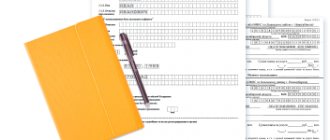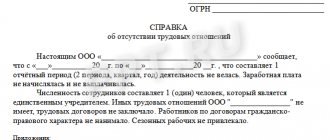Any entrepreneur, striving to increase his profit, feels the inevitable tax burden. It is natural to strive to reduce the cost of paying taxes, but it is important not to cross the line defined by law. However, the tax burden cannot be too low, because in this case there are almost certainly violations of tax legislation, which can be identified by a scheduled or unscheduled audit of the INFS.
What components does the tax burden consist of, what is its role in entrepreneurial activity, how to calculate it at different economic levels, whether an entrepreneur can do it on his own - all these questions are discussed below. Join us!
Absolute and relative tax burden
The concept of tax burden is used to establish the financial obligations of an entrepreneur to the state. It can be viewed as a relative or absolute value.
The amount burdening the entrepreneur due to his duties as a taxpayer, expressed in a certain figure, constitutes the absolute value of the tax burden.
Entrepreneurs need to know this figure in order to plan the ratio of expenses and income, optimize the business, and evaluate its profitability.
Tax authorities interpret the tax burden as a measure characterizing the funds that an entrepreneur allocates from business for his tax expenses. This approach is relative, as it includes many parameters taken into account by the Federal Tax Service.
That is why the relative designation of the tax burden better allows us to analyze the impact of the tax burden on the financial condition of the entrepreneur and the profitability of his business.
Sometimes the tax burden is identified with the effective tax rate - a percentage of the actual payment of a particular tax in the total tax base. When it comes to the tax burden for a specific tax, it is permissible to apply this definition, which is what is done in some regulations.
State documents
Since the tax burden ranks first among the criteria for selecting the “lucky” ones for an on-site tax audit, its documentary regulation relates primarily to documents issued by the Federal Tax Service. The relations between tax payers and regulatory authorities are regulated by the following acts:
- Order of the Federal Tax Service of the Russian Federation “On approval of the Concept of the planning system for on-site tax audits” dated May 30, 2007 No. MM-3-06/333 and its Appendix No. 3 - information data that is replenished and updated annually;
- Letter of the Federal Tax Service of the Russian Federation “On the work of commissions of tax authorities on the legalization of the tax base” dated July 17, 2013 No. AS-4-2/12722 contains a formula for calculating the tax burden for various types of taxes and special tax regimes.
NOTE! All this information is contained on the official website of the Federal Tax Service.
Who needs it and why?
Determining how much money is spent on taxes is an important point that determines the activities of economic entities at various levels:
- taxpayers themselves can assess the effectiveness of their activities, determine how great the risk of a tax audit is, decide on the optimal tax regime, and predict further actions;
- The federal tax service uses these figures to design its regulatory activities, and also has the opportunity to influence the modernization of the tax system as a whole;
- The Ministry of Finance and other economic government agencies, based on tax burden indicators, study the economic situation at the regional and state levels, planning and forecasting the country's future financial policy.
What kind of load will we consider?
The mentioned documents, in addition to informational information, can give entrepreneurs the opportunity to independently calculate the tax burden using specially developed formulas.
The first document (order of the Federal Tax Service) provides a general formula that will help in calculating the total tax burden , that is, the share of funds that were accrued for payment on the basis of tax returns in relation to the amount of revenue recorded by Goskomstat (in the income statement) .
IMPORTANT! Personal income tax is included in the calculation of such a load, but VAT is not. At the same time, contributions to extra-budgetary funds are excluded from the calculations, since not all of them are supervised by the Federal Tax Service.
The second document (letter from the Federal Tax Service) contains several calculation formulas for different taxes and certain special tax regimes.
Indicators that affect the company's tax burden
As can be seen from the above formulas, each initially contains the calculated VAT for transfer. The following data is used to calculate it:
- The tax base. The higher it is, the greater the amount of tax to be transferred;
- The amount of tax deductions claimed in the purchase ledger. The higher this indicator, the lower the amount of VAT to be transferred;
- The amount payable is reduced by the amount of VAT calculated on the construction and installation work performed;
- The amount of tax that was paid to customs officers or to the Federal Tax Service (when importing from EAEU countries) and presented for deduction reduces the indicator for payment;
- The amount of VAT on advance payments to suppliers, with confirmed use of the deduction, reduces the amount to be transferred;
- Closed advances from buyers also reduce the indicator
- The amount of VAT paid as a tax agent also reduces the level of VAT payable.
The taxable base indicator, also participating in the formulas, is affected by the following positions:
- Trade turnover. The higher it is, the higher the taxable base;
- Reduce the base of the operation provided for in Articles 146, 147, 148, 149, 150 of the Tax Code of the Russian Federation;
- Increase the size of the construction and installation work base for the company’s own needs;
- Advances received also increase the basis;
- Selling at 0% also reduces your tax basis.
Formula for calculating the tax burden
Cumulative load
The total tax burden is calculated on a very average basis. Its formula is extremely simple: it is a quotient of tax deductions and revenues. In a more refined version, it might look like this:
НН = СнОг x 100% / СВг - VAT,
Where:
TN – tax burden; SnOg – the amount of taxes paid according to the report in the tax year; СВг – the amount of revenue according to accounting documents corresponding to the tax annual period; it does not include VAT and excise taxes. This technique was developed and recommended for use by the Ministry of Finance of the Russian Federation.
The load will be considered low and will attract close attention from the tax authorities if the calculated indicator is less than the industry average values updated annually on the Federal Tax Service website.
FOR YOUR INFORMATION! There are other methods for calculating the tax burden in the aggregate, proposed in various economic publications.
EXAMPLE. Let's calculate the workload of the conditional Dolgozhdan LLC, which is engaged in the hotel business.
The Federal Tax Service has determined the average load level for this type of business as 9%.
The company's revenue, according to the financial report for 2015, amounted to 40 million rubles. Tax returns filed by the firm this year showed the following tax deductions:
- VAT – 1.1 million rubles;
- income tax – 1.2 million rubles;
- corporate property tax – 520 thousand rubles;
- transport tax – 250 thousand rubles.
Personal income tax was withheld from employee salaries in the amount of 750 thousand rubles. Insurance premiums, as well as transfers to the Pension Fund, have no significance for this calculation.
Tax burden of Dolgozhdan LLC : 1,100,000 + 1,200,000 + 520,000 + 250,000 + 750,000 = 2,625,000 rubles. Divide by the profit indicator: 2,625,000 / 40,000,000 = 0.065. Multiply by 100%, we get 6.5%.
The calculated result is less than the average (9%) determined by the Federal Tax Service for this business sector. Therefore, Dolgozhdan LLC will be included in the plan of on-site tax audits, or its employees will be called to the tax office to give explanations.
How to explain the low tax burden
Almost every newly opened enterprise will have a level below that required by law. Typically, fiscal services take into account the date of creation of the company during each document check, but it may be necessary to provide additional clarification to the Federal Tax Service.
It will be more difficult for those companies that have been operating for more than one year, and the tax burden has recently decreased. In this case, most often the reason is indicated by activities under several OKVED - tax authorities often use only the main type of economic activity for calculations, so the data may be overestimated. In this case you can:
- change the main OKVED code and inform the fiscal service that you have worked according to it before - this is not prohibited by law;
- independently calculate the tax burden separately for each type of company activity.
Recalculation of the load can also be useful in terms of checking whether personal income tax was included in the calculation of the tax burden. The Federal Tax Service often forgets about this tax, and the result is an overestimated figure.
If all values are calculated correctly, then the company can explain its underestimated tax burden ratio as follows:
- Not only production activities are carried out, but there are also investment investments;
- a lot of effort is aimed at developing the production (or trade) network;
- the development of a new type of activity has begun (suitable for companies that have been operating for several years).
You can also point out to tax officials data from statistics for a specific region and industry that during this period there were objective reasons for the deterioration of affairs. This could be a decline in the area of business activity or in a related area where the main buyers are located, etc. For example, the following objective circumstances for reducing the tax burden are often indicated:
- decrease in product sales volumes;
- a strong increase in the cost of raw materials from suppliers;
- increase in administrative expenses, employee salaries, and other costs.
All data must be supported by reports from previous periods, where everything was in order and the tax burden was higher. Then it will be clear that the company is really facing problems at this time, which resulted in a decrease in transfers to the budget.
Load for a specific tax
Most often, the tax burden is calculated using VAT and income tax.
Level of income tax burden
The Federal Tax Service will be alert if it is below the following indicators:
- for trade enterprises – less than 1%;
- for other organizations, including those involved in production and contracting - less than 3%.
It is calculated using the following formula:
ННп = Нп / (Др + Двн),
where: ННп – tax burden for income tax; Np – income tax based on the results of the annual declaration; Др – income from sales, determined according to the profit declaration data; Dvn – other (non-operating) income of the organization according to the same declaration. The result obtained is multiplied by 100%.
Level of tax burden for VAT
The Federal Tax Service recognizes the level of tax burden for VAT as low if for all four quarters of the reporting year the amount of tax deductions for VAT amounts to 89% or more of the total amount of this tax.
There are several ways to calculate the VAT burden.
- Divide the amount of VAT paid (NVAT) into the tax base indicators in accordance with section 3 of the corresponding declaration, focusing on the state of the Russian market (NBrf): Tax
Tax on VAT = NNDS / NBRf - Find the ratio of the amount of VAT according to the declaration (NVAT) to the total tax base, which includes both indicators of the Russian market and the export market (NBtot):
NV for VAT = NNAT / Nbtot.
Calculation of tax burden for income tax
The tax burden indicator is by no means an abstract concept - it has a calculation formula and a set range of acceptable values. Every year, the Federal Tax Service adjusts these indicators by industry taking into account the current economic situation. Data for 2020 are determined by Appendix No. 3 of the Order of the Federal Tax Service of Russia dated May 30, 2007 No. MM-3-06 / [email protected] (as amended on May 10, 2012).
So what is the tax burden? This indicator characterizes the share of all tax payments in the company’s revenue for a certain period and is measured as a percentage. At the end of each tax period, Federal Tax Service employees compare the amount of tax payments transferred by the company and their recommended value.
However, you should not think that the decision to include an organization in the calendar of on-site inspections is made based on the results of only one period - tax authorities will analyze several time intervals.
It is not difficult to calculate the tax burden (for income tax and other fiscal payments in general). It is enough to use the formula:
Total tax burden = Total amount of taxes accrued for the year / Company revenue for the same period x 100%.
The value of the revenue indicator is taken from the “Income Statement” (line 2110).
The above formula allows you to determine the overall level of tax burden for the company. However, the share of taxes can be determined not only in relation to the total amount of tax payments, but also for a specific tax. The Federal Tax Service provides for the possibility of calculating the fiscal burden on the basis of other indicators - income tax and value added tax.
Nuances of the tax burden for different types of entrepreneurs
- IP . An individual entrepreneur must calculate the tax burden for personal income tax. To do this, you need to divide the indicator in your declaration by the 3-NDFL given in the declaration.
- Payers of the simplified tax system must take the level of their load accrued in accordance with the declaration and divide it by income in accordance with 3-NDFL.
- Entrepreneurs on the unified agricultural tax divide, accordingly, their tax indicators by the amount of income according to the 3-NDFL declaration.
- Those who chose OSNO add up VAT and income tax and find the ratio of the amount received to the total revenue reflected in the income statement.
IMPORTANT INFORMATION! If a businessman, in addition to those listed, pays other taxes, for example, land, water, property, etc. (except for personal income tax), then all these taxes will participate in the calculation of the total burden.
If the level of the tax burden turns out to be low, this does not mean mandatory penalties: they can only be imposed based on the results of an audit, the risk of which naturally increases in such a situation.
How to act
So, let’s assume that your company has a high level of fiscal deductions for VAT. In this case, proceed in order:
- Prepare explanations. A high level of VAT deductions is not a crime. They are not accusing you of anything, but simply want to check whether you are applying the current legislation correctly. There's no need to panic. Prepare detailed and detailed explanations of the circumstances.
- If explanations to the tax authorities are not enough and you are invited to the inspectorate for a conversation, then you should not avoid the meeting. Show up with your passport at the appointed time. If necessary, take your constituent documents with you. Answer all questions. A conversation with a representative of the Federal Tax Service is a certain type of check that allows you to find out whether the company is a one-day company.
- If a personal meeting did not convince you, and the Federal Tax Service initiated on-site control, then you should not despair. Inspectors will check documentation (contracts, invoices, purchase and sales books). Help the controllers; there is no need to create obstacles.
Let us remind you that a high level of VAT deductions is not a crime. The Federal Tax Service has the right to assess additional tax only on the basis of violations identified as a result of an on-site inspection.
Legal documents
- Tax Code of the Russian Federation








